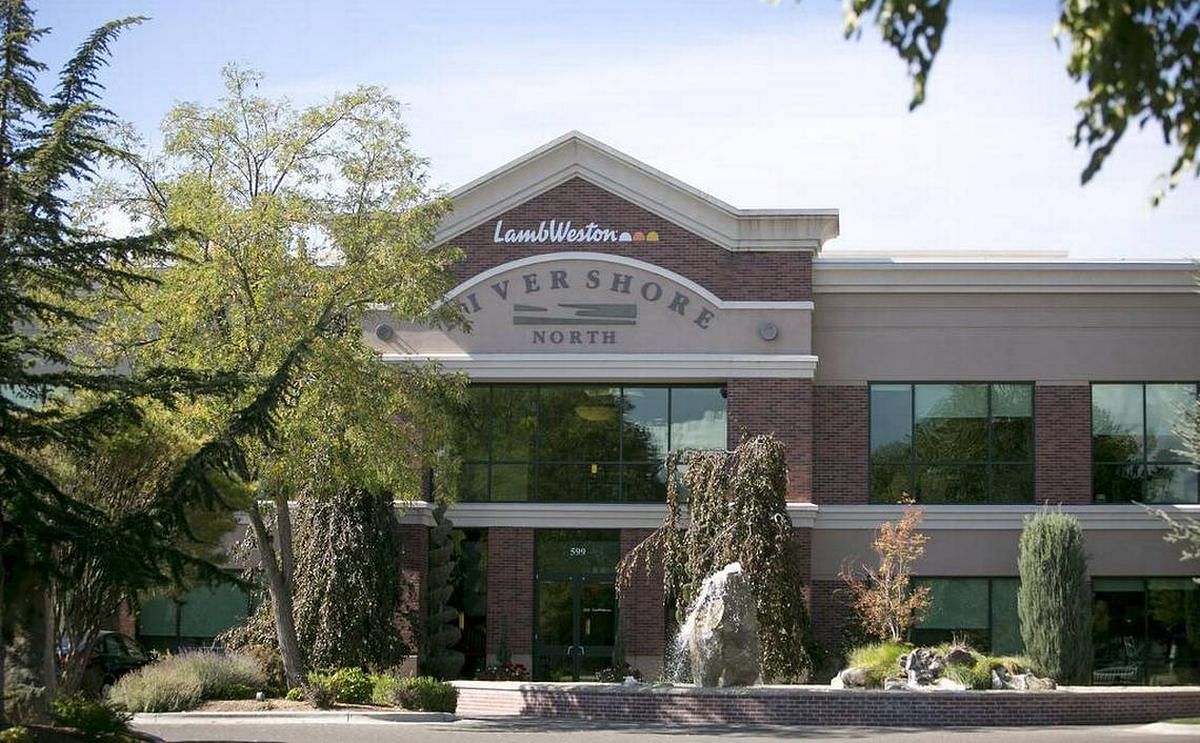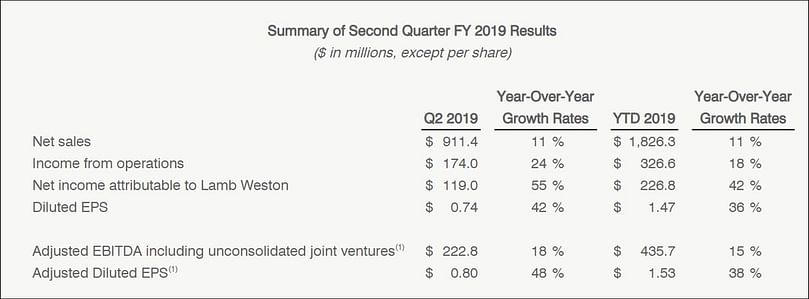Lamb Weston headquarters in Eagle, Idaho (Courtesy: Idaho Statesman)
Potato Processor Lamb Weston Reports Fiscal Second Quarter 2019 Results

Lamb Weston Holdings, Inc. (NYSE: LW) announced today its fiscal second quarter 2019 results and updated its full year outlook.
Tom Werner, President and CEO:
“We delivered another quarter of strong sales, earnings and cash flow growth.”
“We’re executing well across the organization and continue to expect the operating environment in North America to remain generally favorable for the remainder of fiscal 2019.”
“As we’ve previously indicated, while we anticipate delivering solid sales and earnings results in the second half of fiscal 2019, our performance will moderate as we begin to lap strong prior year results, face increased cost inflation, ramp up investments in operating, sales and product innovation capabilities, and tackle the challenges arising from a historically poor potato crop in Europe.”
“Despite these headwinds, due to our strong first half performance and operating momentum, we have raised our annual outlook for sales growth and EBITDA.”
“In addition, we’ve recently taken actions that we believe demonstrate our balanced, returns-driven approach when deploying capital.”
“First, we completed the purchase of our partner’s interest in our Lamb Weston BSW joint venture in December.”
“Second, consistent with our strategy to differentiate our global supply chain to drive growth, we acquired a frozen potato processor in Australia, which will provide us with additional capacity to serve our customers.”
“Third, we increased our quarterly dividend by approximately 5 percent, enabling us to maintain a dividend payout range of 25 to 35 percent of Adjusted Diluted EPS.”
“And finally, we adopted a $250 million share repurchase program designed to buy back stock on an opportunistic basis. We believe these actions, along with our performance, show our commitment to executing on our strategies to support customers, drive growth and create value for our shareholders over the long term.”
Q2 2019 Commentary
Net sales were $911.4 million, up 11 percent versus the year-ago period. Price/mix increased 6 percent due to pricing actions and favorable mix. Volume increased 5 percent, driven by growth in the Company’s Global and Retail segments.
Income from operations rose 24 percent to $174.0 million from the prior year period, which included $4.0 million of pre-tax costs in the prior year period related to the Company’s separation from Conagra Brands, Inc. (formerly ConAgra Foods, Inc., “Conagra”) on November 9, 2016.
Excluding this comparability item, income from operations grew $30.2 million, or 21 percent, driven by higher sales and gross profit. Gross profit increased $40.8 million due to favorable price/mix, volume growth and supply chain efficiency savings. This increase was partially offset by transportation, warehousing, input and manufacturing cost inflation. In addition, gross profit included a $1.7 million loss related to unrealized mark-to-market adjustments and realized settlements associated with commodity hedging contracts in the current quarter, compared with a $0.6 million loss related to these items in the prior year period.
The rise in gross profit was partially offset by a $10.6 million increase in selling, general and administrative expenses (“SG&A”), excluding comparability items. The increase was largely driven by higher expenses related to information technology services and infrastructure, as well as investments in the Company’s sales, marketing and operating capabilities. The increase in SG&A also includes approximately $2 million of unfavorable foreign exchange, which was more than offset by an approximately $4 million benefit from an insurance settlement.
Adjusted EBITDA including unconsolidated joint ventures(1) was $222.8 million, up 18 percent versus the prior year period, primarily due to growth in income from operations.
Diluted EPS increased $0.22, or 42 percent, to $0.74, which included a $0.10 benefit related to a lower U.S. corporate tax rate as a result of the U.S. Tax Cuts and Jobs Act (the “Tax Act ”) enacted in December 2017, partially offset by a $0.06 decrease related to the acquisition of the remaining interest of the Company’s Lamb Weston BSW, LLC (“Lamb Weston BSW”) joint venture. The remaining increase in diluted EPS reflects growth in income from operations.
Adjusted Diluted EPS(1) increased $0.26, or 48 percent, to $0.80, which included a $0.10 benefit related to a lower U.S. corporate tax rate as a result of the Tax Act. The remaining increase in Adjusted Diluted EPS reflects growth in income from operations.
The Company’s effective tax rate(2) in the second quarter of fiscal 2019 was 21.5 percent. The lower rate in the second quarter of fiscal 2019 versus 33.3 percent in the prior year period is primarily attributable to the effects of the Tax Act, as well as the benefit of foreign-related discrete items.
Full Financial Release
For the full financial release, including additional details, the outlook for the remainder of 2019, as well as the explanations of the notes, we refer to the Lamb Weston Holdings websiteQ2 2019 Segment Highlights
Global Segment Summary
Net sales for the Global segment, which is comprised of the top 100 North American based restaurant chain customers as well as the Company’s international business, increased to $470.0 million, up 13 percent compared to the prior year period.Price/mix increased 7 percent, reflecting the carryover impact of pricing actions taken in the prior year as well as improved mix. Volume increased 6 percent, driven by growth in sales to strategic customers in the U.S. and key international markets, as well as the benefit of limited time product offerings.
Global segment product contribution margin(1) increased to $112.4 million, up 28 percent compared to the prior year period. Favorable price/mix, volume growth and supply chain efficiency savings drove the increase, which was partially offset by transportation, warehousing, input and manufacturing cost inflation.
Foodservice Segment Summary
Net sales for the Foodservice segment, which services North American foodservice distributors and restaurant chains outside the top 100 North American based restaurant chain customers, increased to $279.7 million, up 3 percent compared to the prior year period.Price/mix increased 5 percent, reflecting the carryover impact of pricing actions taken in the prior year as well as improved mix. Volume declined 2 percent largely due to the loss of some lower-margin volume, partially offset by growth of sales of higher-margin products.
Foodservice segment product contribution margin(1) increased to $97.4 million, up 6 percent compared to the prior year period, driven by favorable price, improved mix and supply chain efficiency savings, partially offset by transportation, warehousing, input and manufacturing cost inflation.
Retail Segment Summary
Net sales for the Retail segment, which includes sales of branded and private label products to grocery, mass merchant and club customers in North America, increased to $123.9 million, up 21 percent compared to the prior year period.Volume increased 16 percent, primarily driven by distribution gains of Grown in Idaho and other branded products, as well as private label products. Price/mix increased 5 percent, due to higher prices across the branded and private label portfolios, as well as improved mix.
Retail segment product contribution margin(1) increased to $25.9 million, up 34 percent compared to the prior year period, due to higher price/mix, volume growth and supply chain efficiency savings. The increase was partially offset by transportation, warehousing, input and manufacturing cost inflation.
Outlook
As summarized in the table above, the Company expects:
- Net sales to grow mid-to-high single digits, with price/mix higher in the first half of fiscal 2019 versus the second half of the fiscal year, reflecting the carryover impact of customer contract pricing structures that took effect beginning in the second half of fiscal 2018. The Company’s previous estimate was for net sales to grow mid-single digits.
- Adjusted EBITDA including unconsolidated joint ventures(1) in the range of $870 million to $880 million, an increase from the Company’s previous estimate of $860 million to $870 million.
For fiscal 2019, the Company expects:
- The rate of gross profit dollar growth to be at least in line with net sales growth.
- To incur significantly higher SG&A as it invests to upgrade its information systems and enterprise resource planning infrastructure, as well as sales, marketing, innovation, operations and other functional capabilities, designed to drive operating efficiencies and support future growth.
- Equity method investment earnings to decline versus the prior year, reflecting the effect of significantly higher raw potato prices in Europe.
- The range also includes the impact of the Company exercising its contractual right to purchase the remaining 50.01% equity interest in its joint venture, Lamb Weston BSW, that it did not own. While the transaction closed in December 2018, the Company ceased recording a noncontrolling interest in the Lamb Weston BSW joint venture on its Consolidated Statement of Earnings as of November 2, 2018, the date on which the Company entered into a definitive agreement to purchase the interest.
- Total interest expense to be approximately $110 million.
- An effective tax rate(2) of approximately 23 percent, down from the Company’s previous estimate of approximately 24 percent.
- Cash used for capital expenditures of approximately $360 million.
- Total depreciation and amortization expense of approximately $150 million.
Like to receive news like this by email? Join and Subscribe!
Get the latest potato industry news straight to your WhatsApp. Join the PotatoPro WhatsApp Community!
Highlighted Company
Sponsored Content
Sponsored Content
Sponsored Content
Sponsored Content

















